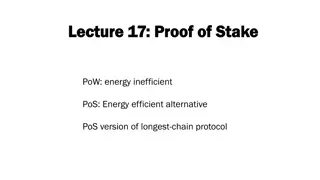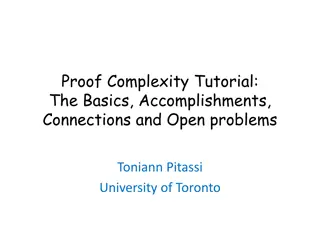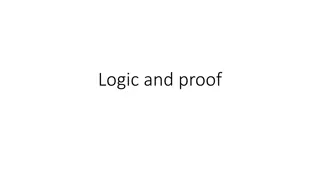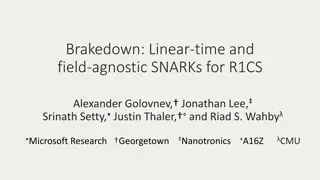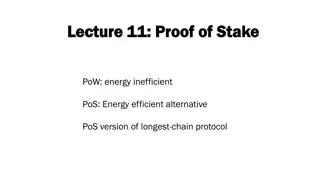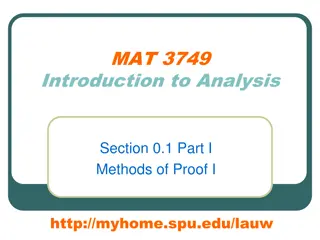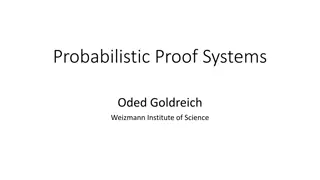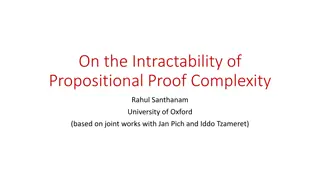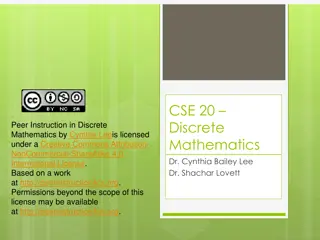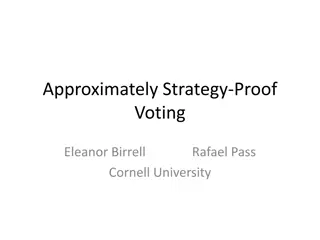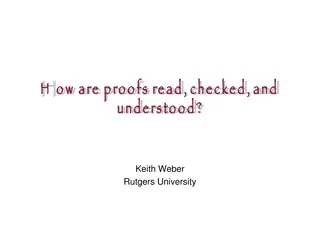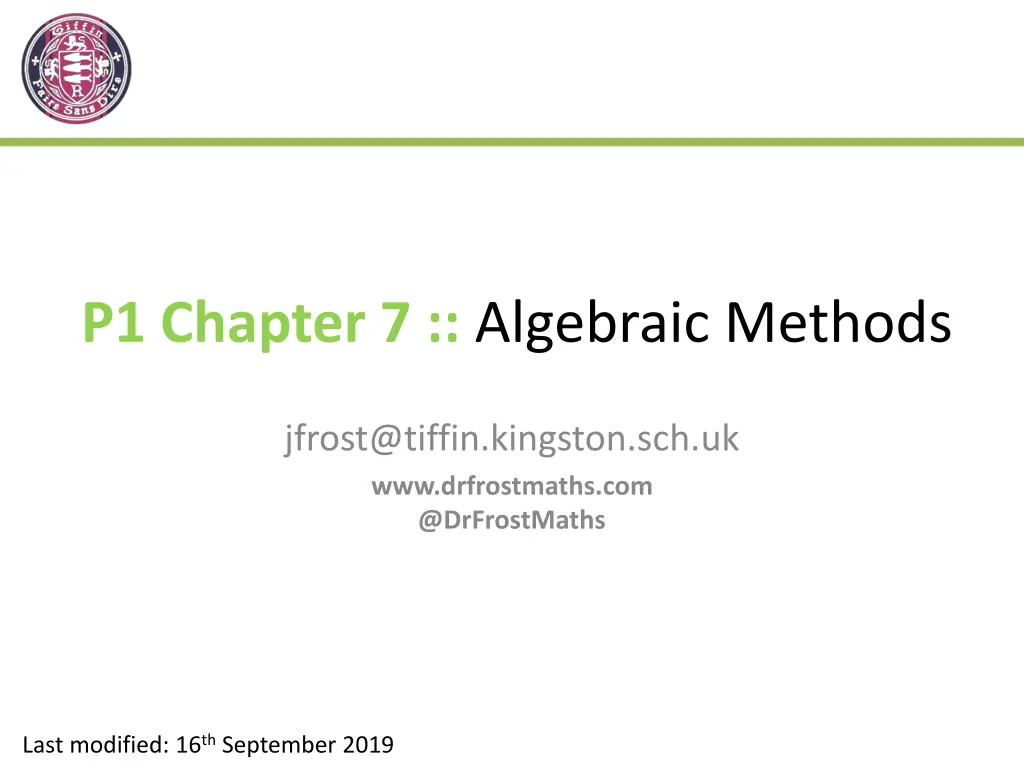
Introduction to Algebraic Proof Techniques
Explore algebraic proof methods including deductive reasoning, theorem validation, and famous mathematical conjectures like Goldbach's Conjecture. Understand the importance of clear steps, logical sequences, and covering all cases in mathematical proofs.
Download Presentation

Please find below an Image/Link to download the presentation.
The content on the website is provided AS IS for your information and personal use only. It may not be sold, licensed, or shared on other websites without obtaining consent from the author. If you encounter any issues during the download, it is possible that the publisher has removed the file from their server.
You are allowed to download the files provided on this website for personal or commercial use, subject to the condition that they are used lawfully. All files are the property of their respective owners.
The content on the website is provided AS IS for your information and personal use only. It may not be sold, licensed, or shared on other websites without obtaining consent from the author.
E N D
Presentation Transcript
P1 Chapter 7 :: Algebraic Methods jfrost@tiffin.kingston.sch.uk www.drfrostmaths.com @DrFrostMaths Last modified: 16th September 2019
4 :: Proof Terminology A conjecture is a mathematical statement that has yet to be proven. One famous conjecture is Goldbach s Conjecture. It states Every even integer greater than 2 can be expressed as the sum of two primes. It has been verified up to 4 1018(that s big!); this provides evidence that it is true, but does not prove it is true! A theorem is a mathematical statement that has been proven. One famous misnomer was Fermat s Last Theorem, which states If ? is an integer where ? > 2, then ??+ ??= ?? has no non-zero integer solutions for ?,?,?. It was 300 years until this was proven in 1995. Only then was the Theorem in the name then correct!
Types of Proof A proof must show all assumptions you are using, have a clear sequential list of steps that logically follow, and must cover all possible cases. You should usually make a concluding statement, e.g. restating the original conjecture that you have proven. An identity is an equation that is true for all values of the variables. e.g. ?2= 4 is true only for ? = 2, but ? ? 1 ?2 ? is true for all ?. a. Proof by Deduction This is the simplest type, where you start from known facts and reach the desired conclusion via deductive steps. Prove that ?? + ? ? ? ? + ? ???+ ??? ???? ?? 3? + 2 ? 5 ? + 7 = 3? + 2 ?2+ 2? 35 = 3?3+ 6?2 105? + 2?2+ 4? 70 = 3?2+ 8?2 101? 70 Prove that the product of two odd numbers is odd. Let ?,? be integers, then 2? + 1 and 2? + 1 are odd numbers. 2? + 1 2? + 1 = 4?? + 2? + 2? + 1 = 2 2?? + ? + ? + 1 This is one more than a multiple of 2, and is therefore odd. ? ? 3? + 2 ? 5 ? + 7 3?3+ 8?2 101? 70
Be Warned Proof by Deduction requires you to start from known facts and end up at the conclusion. It is not acceptable to start with to the conclusion, and verify it works, because you are assuming the thing you are trying to prove. Example: Prove that if three consecutive integers are the sides of a right-angled triangle, they must be 3, 4 and 5. Correct Proof: Incorrect Proof: We are assuming the thing we are trying to prove! If the sides are consecutive, then let the sides be: ?,? + 1,? + 2 Then by Pythagoras Theorem: ?2+ ? + 12= ? + 22 ?2 2? 3 = 0 ? + 1 ? 3 = 0 ? = 3 (as ?can t be negative) Thus the sides are 3, 4, 5. Let the lengths be 3,4,5. Therefore: 32+ 42= 52 25 = 25 This satisfies Pythagoras Theorem, and the numbers are consecutive. ? We are only assuming things in the if bit. This is fine! ? The underlying problem is that this technique doesn t prove there can t be other consecutive integers that work we have only verified 3,4,5 is one such solution.
Types of Proof Fro Exam Tip: This is quite a common last parter. a. Proof by Deduction Prove that ??+ ?? + ? is positive for all values of ?. ?2+ 4? + 5 = ? + 22+ 1 ? + 22 0 for all ? ? + 22+ 1 1 > 0 Anything squared is at least 0. This is formally known as the trivial inequality . ? Test Your Understanding Prove that the sum of the squares of two consecutive odd numbers is 2 more than a multiple of 8. Let 2? 1 and 2? + 1 be any two consecutive odd numbers, where ? is an integer. 2? 12+ 2? + 12= 4?2 4? + 1 + 4?2+ 4? + 1 = 8?2+ 2 which is 2 more than a multiple of 8. ?
Exercise 7D Pearson Pure Mathematics Year 1/AS Pages 149-150 Extension [STEP I 2005 Q1] 47231 is a five-digit number whose digits sum to 4 + 7 + 2 + 3 + 1 = 17. (i) Prove that there are 15 five-digit numbers whose digits sum to 43. You should explain your reasoning clearly. (ii) How many five-digit numbers are there whose digits sum to 39? i) Since 5 9 = 45 then the digits drop by 2 in total from the maximum of 9, 9, 9, 9, 9. This can either be on one number (9,9,9,9,7) or spread across two numbers (9,9,9,8,8). If 9, 9, 9, 9, 7 are used, the 7 can go in 5 positions, giving 5 numbers. If 9, 9, 9, 8, 8 is used, the two 8s can go in 5 4 2 = 10 positions (as there are 5 choices for the first 8 and 4 for the second, but they can go either way round). Thus there are 5 + 10 = 15 possibilities. ? i ii) This time we must drop the digit sum by 6 from the maximum of 9,9,9,9,9. This gives the possibilities: (9,9,9,9,3), (9,9,9,8,4), (9,9,9,7,5), (9,9,8,8,5), (9,9,9,6,6), (9,9,8,7,6), (9,8,8,8,6), (9,9,7,7,7), (9,8,8,7,7), (8,8,8,8,7). This give 5, 20, 20, 30, 10, 60, 20, 10, 30, 5 possibilities respectively, giving 210 possibilities in total. (I have omitted the calculation for each for brevity) ? ii
Other Types of Proof b. Proof by Exhaustion c. Disproof by Counter-Example This means breaking down the statement into all possible smaller cases, where we prove each individual case. (This technique is sometimes known as case analysis ) While to prove a statement is true, we need to prove every possible case (potentially infinitely many!), we only need one example to disprove a statement. This is known as a counterexample. Prove that ??+ ? is even for all integers ?. ? is either even or odd. If ? is even: ?2+ ? = ???? ???? + ???? = ???? + ???? = ???? Disprove the statement: ?? ? + ?? is prime for all integers ?. If ? = 41, then we have 412 41 + 41 = 412 ? Which is not prime as it has a factor of 41. Thus the statement is not true. ? If ? is odd: ?2+ ? = ??? ??? + ??? = ??? + ??? = ???? ?2+ ? is even for all integers ?.
Exercise 7E Pearson Pure Mathematics Year 1/AS Pages 152-154




